Guide to the Shrine Precincts
The Shrine and Precincts
This is a guide to the Shrine of Kumano. Thirty gods are worshipped in the shrine precincts, and there are various facilities such as a museum and charm shop. The configuration of the shrine precincts are introduced in this list.
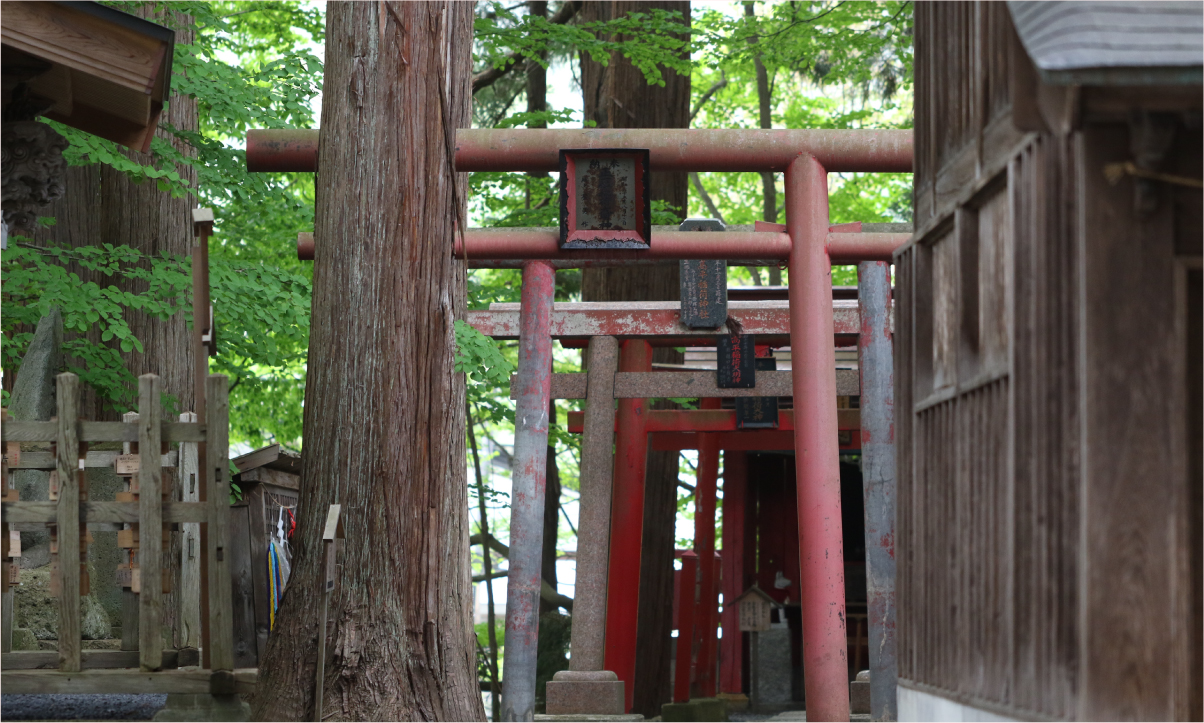
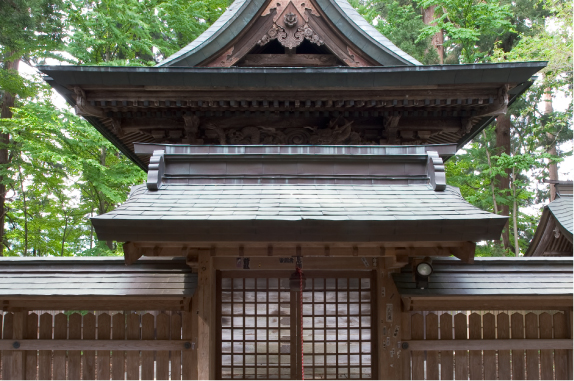
Honden (Main Hall)
Enshrined Deities: Kumanohusumi no Okami, Izanami no Mikoto
Buddhist Divinities: Behind the Hongu (Main Hall) three carvings of rabbits are hidden, and it is said that those who find all of them will have no money problems, will be happy, and will have their requests granted. Kannon Bodhisattva the Goddess of Life Energy
Fusumi means “Musuhi”, the force that brings forth all sorts of life. In the age of the gods first joined to Izanami no mikoto in marriage pledge, and bringing forth many gods and all living beings, has come to be worshipped as the god of life, joining, marriage, and industry.
Here we will introduce the proper etiquette and procedure. When visiting, visit with a thankful heart and a bright, pure, simple spirit.
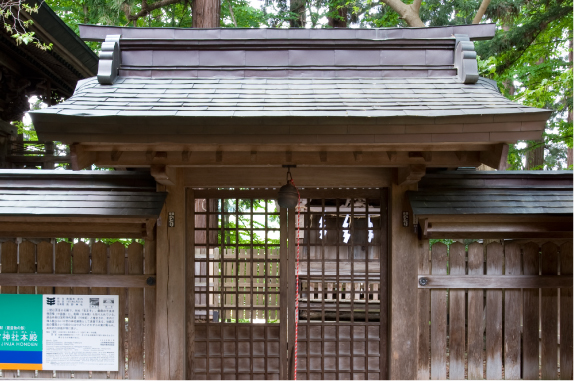
Ninomiyajinjashaden (Secondary Shrine)
Enshrined Deities: Kumanohayatama no Okami, Izanami no Mikoto
Buddhist Divinity: Yakushi Nyorai
Godly Virtue: God of Life
In the age of the gods, the first to be pledged in marriage, Izanami no mikoto, bringing forth many gods and all living beings. “Haya” means vigor, and “tama” means soul, representing a vital spirit and life. He has come to be worshipped as brings forth all forms of life.
● The hall is a designated prefectural cultural property. Also called Nyauku-oji, it is built of wood and thatched with copper plate the traditional Shinto ikkenja style, it was constructed in the Muromachi Period.
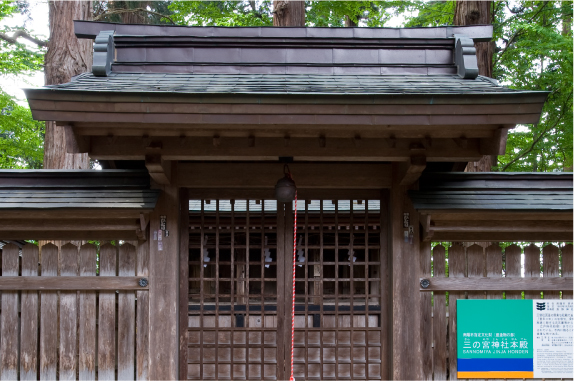
Sannomiyajinjashaden (Tertiary Shrine)
Enshrined Deities: Kumanoketsumiko no Okami, Susano no Mikoto
Buddhist Divinity: Amidanyorai
Godly Virtue: God of Food
A god born of the union of Kumanohusumi no Okami and Kumanohayatama no Okami. The character for “house” in his name means “food”, so this is the god of food which is of utmost importance for human survival.
This is also a god who takes the sins of people into its own self.
●The hall is a designated municipal cultural property built in a 3 wave traditional Shinto architectural style. It was constructed in the Edo period.
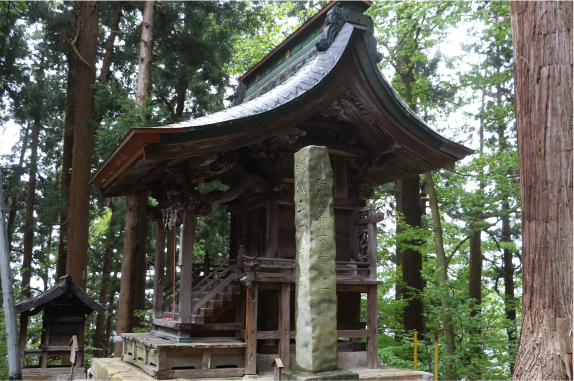
Hachiman Shrine
Enshrined Deity: Ohjin Tenno
Godly Virtues: Prayer for victory, Guardian god of Dog and Boar Zodiac
Hachiman is the divine spirit of the Emperor Ohjin, a god of war who was worshipped as the clan god of the Seiwa Genji clan, and also greatly revered by Minamoto no Yoshiie. Shigeyoshi Ozaki brought it to this mountain when he was transferred from Shinshu in 1598, and the new deity was installed by Abe Umanosuke in 1626.
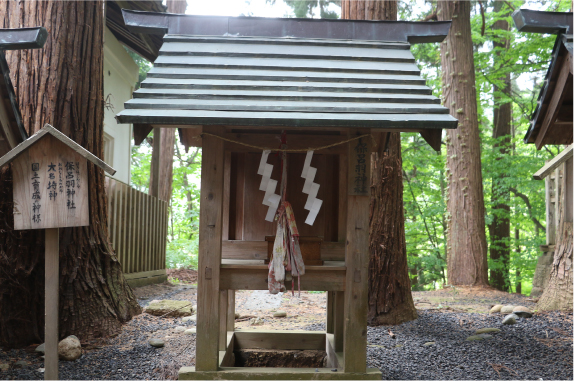
Horoha Shrine
Enshrined Deity: Ohnamochi no Kami
Famous as Ohkuninushi no Kami, the god who cultivates the national land and created the nation. Having great knowledge, especially of medicine and healing, he is worshipped as a god who gets rid of plagues.
Enshrined on this mountain by Irube Matsunaga in 1598.
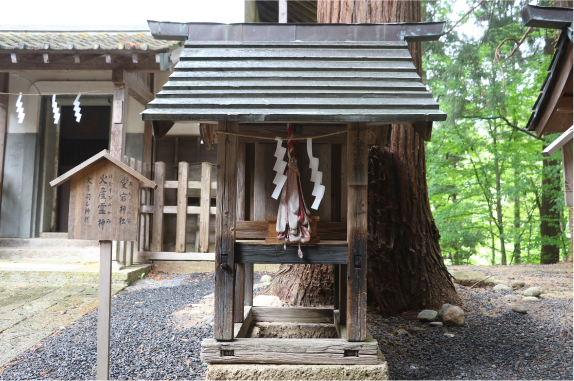
Atago Shrine
Enshrined Deities: Homusubi no Hami, Kagutsuchi no Mikoto
Worshipped from ancient times as a god with wondrous powers of protection and prevention of fire. It’s said if one pays a devotional visit here before the age of three, they will be protected from fire for all their life.
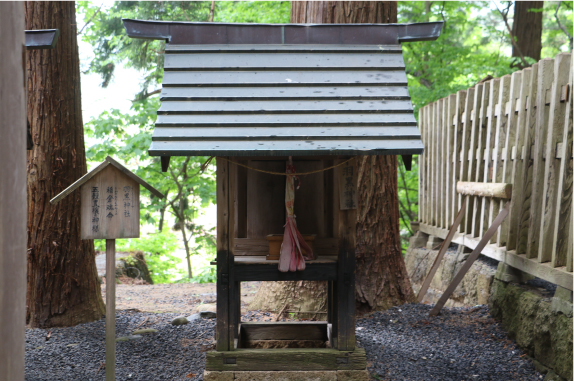
Haguro Shrine
Enshrined Deity: Ukanomitama no Mikoto
“Uka” meaning grain and food, this is the god who created grain. He is worshipped as the god of farming. This god brings forth an abundant harvest.
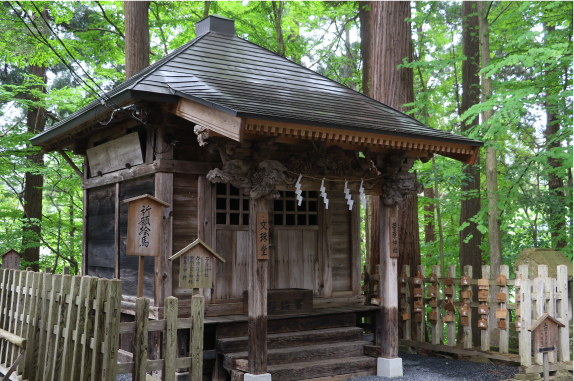
Sugawara Shrine
Enshrined Deity: Sugawara no Michizane
Buddhist Divinity: Monju Bodhisattva,
Godly Virtues: Academic Achievement, Test Taking, Guardian God of the Rabbit
Zodiac
Worshipped under the name of Tenjinsama, the deified spirit of Sugawara Michizane. It has a large following as the god of learning.
Brought to this mountain from Iiyama in Shinshu by Shigeyoshi Ozaki in 1598.
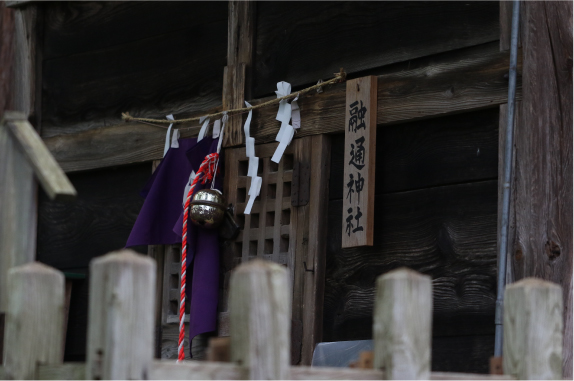
Yutsu Shrine
Enshrined Deity: Tsunugui no Mikami
Buddhist Divinity: Fugen Bodhisattva
Godly Virtues: Guardian God of the Dragon and Snake Zodiac
“Kui” means to sprout forth as when a bud begins to sprout.
The name of this god shows gratitude for the generative power of nature to bring forth and raise living things.
It is worshipped with the meaning of gratitude for nature and the land.
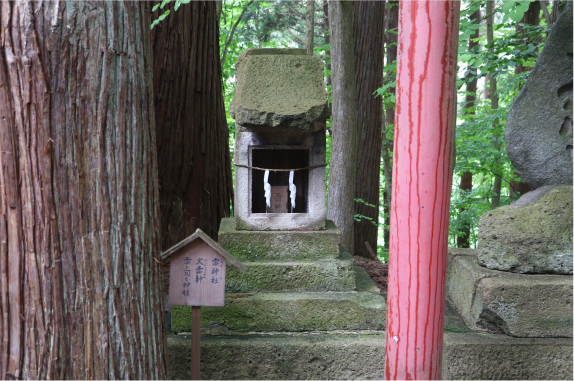
Igatsuhi Shrine
Enshrined Deity: Honoikazuchi no Kami
Godly Virtue: Dispelling Malevolence
Worshipped as Raijin. Humans are powerless before natural disasters such as lightning, which was feared beyond human comprehension.
Because of this, it has been enshrined at present as the god of lightning, and is believed by people working with electricity.
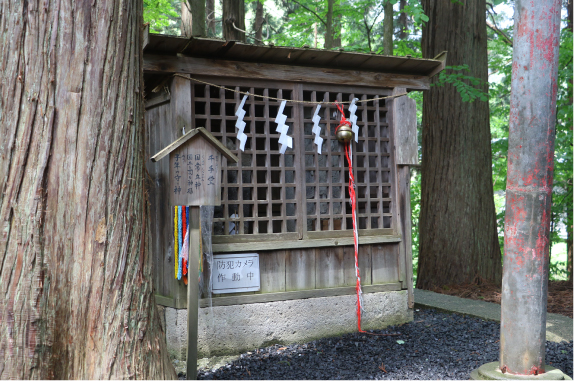
Senju Kannon
Enshrined Deity: Kunitokotachi no Kami
Buddhist Divinity: Senju Kannon
Godly Virtue: Guardian god of the Mouse Zodiac
A god who appeared when heaven and earth were born.
“Kuninotokotachi” has the meaning of the nation continuing in perpetuity, and is worshipped as a god who maintains the stability of the nation’s land.
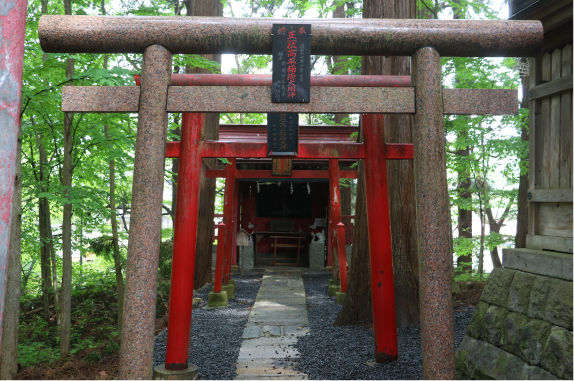
Inari Shrine
Enshrined Deity: Uganomitamo no Okami
Godly Virtues: Abundant Harvests, Prosperous Business
Known also as Inari Daimyojin, and more familiarly as Oinari-sama and Oinari-san.
A god of grain and agriculture, it is also believed to be a god of industry in general, and especially of prosperous business.
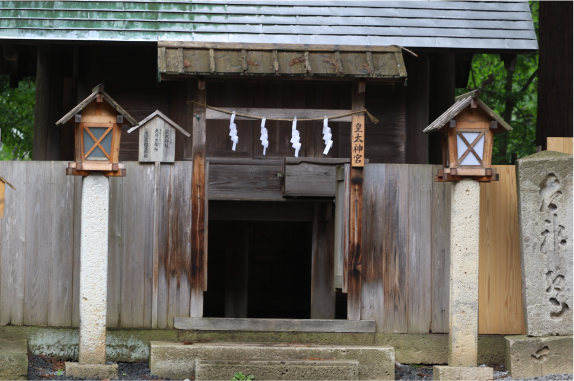
Kohtai Shrine
Enshrined Deity: Amaterasu Okami
Godly Virtue: God of Food
A goddess born of Izanagi no Mikoto and Izanami no Mikoto.
An ancestor goddess of the Imperial Household, she is the national god of the Japanese people. Brought to this mountain by Ozaki Shigeyasu from Shinshu in 1598.
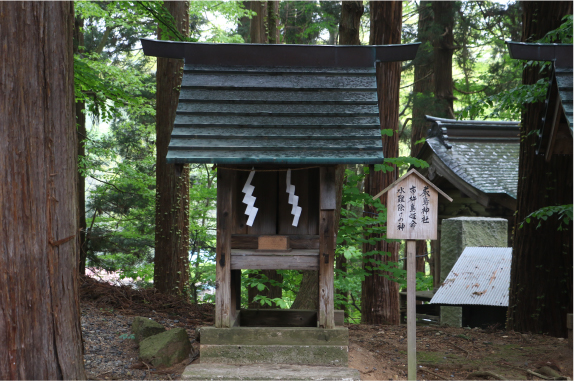
Itsukushima Shrine
Enshrined Deity: Ichikishimahime no Mikoto
Buddhist Divinity: Benzaiten
Godly Virtues: God of Water, Improvement in Fortune
As a god involved with water, it protects us from water damage.
Also syncretized with the Buddhist Benzaiten, it is worshipped as a god who can improve fortune in finances.
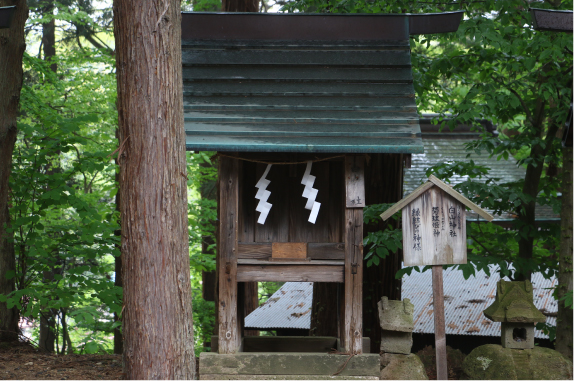
Hakusan Shrine
Enshrined Deity: Kukurihime no Kami
Godly Virtue: Marriage
Kukurihime no Kami is considered to be the same as Shirayamahime no Kami. Her worship as a god of marriage has its origin in her helping Izanagi no Mikoto and Izanami no Mikoto resolve their arguments.
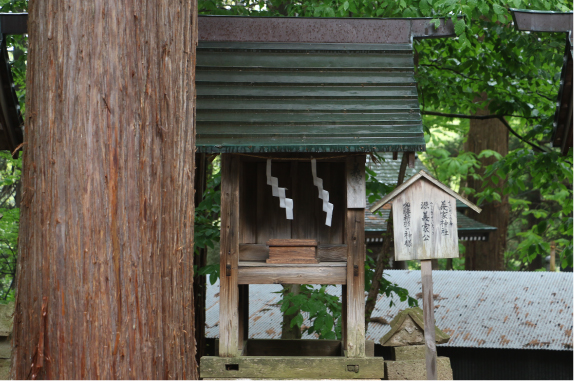
Yoshiie Shrine
Enshrined Deity: Minamoto no Yoshiie
Godly Virtues: Fortune in War, Family Prosperity
Minamoto no Yoshiie expended great efforts to resolve the Former 9 Years War that shook the Tohoku region. At that time, it is said that he was re-established as a deity from Kishu to Kumano Shrine. Presently he is worshipped as a god of victory.
Constructed on this mountain by Yoshihide Nagai in 1250.
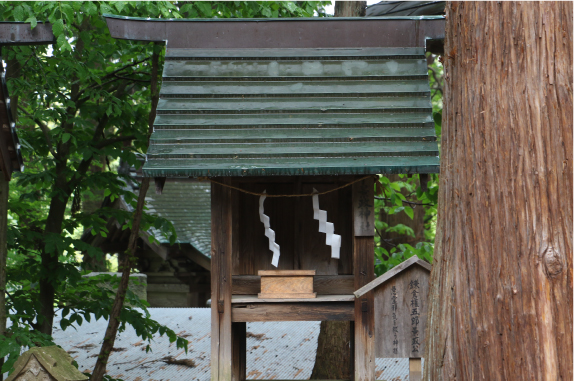
Kagemasa Shrine
Enshrined Deity: Kamakura Gengoro Kagemasa-koh
Godly Virtues: Fulfilling Resolutions, Healing Eye Maladies, Removing Malevolence
Under orders from Minamoto no Yoshie, Kamakura Gengoro Kagemasa left Kishu and was brought to Kumano Shrine, where he is said to have planted the big ginko tree by hand.
Because of an anecdote telling how he continued to struggle after being hit in the right eye during military service after serving his post for three years, he is worshipped as a god who fulfills resolutions, heals eyes, and removes malevolence.
Constructed on this mountain by Yoshihide Nagai in 1250.
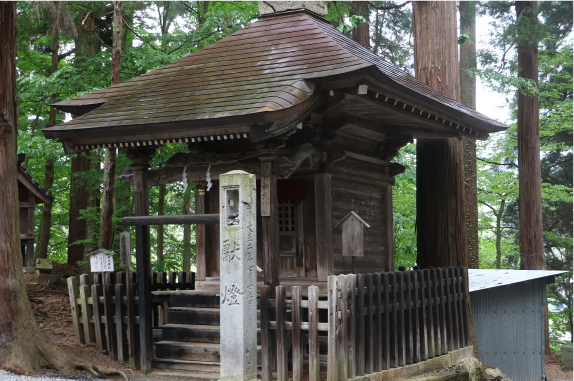
Wakoh Shrine
Enshrined Deity: Toyokumunu no Kami
Buddhist Divinity: Kokuzoh Bodhisattva
Godly Virtues: Guardian God of Tiger and Ox Zodiac
Before the land had taken shape in the age of the gods, this god appeared as a sprouting reed. It is worshipped as a god who gave shape to the land and develops the earth.
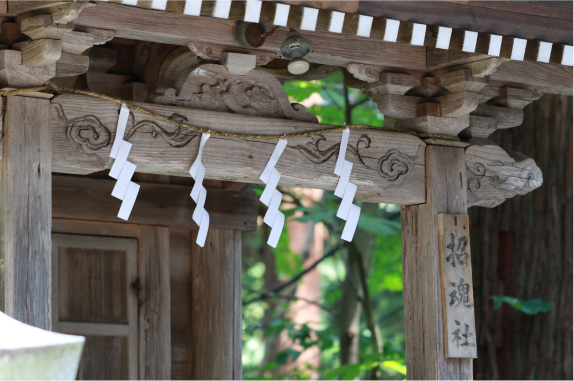
Shokon Shrine
Like Yasukuni Shrine and Gokoku Shrine, since the Meiji Era, this is a shrine for worshipping the souls of people from this region who died in service to their country.
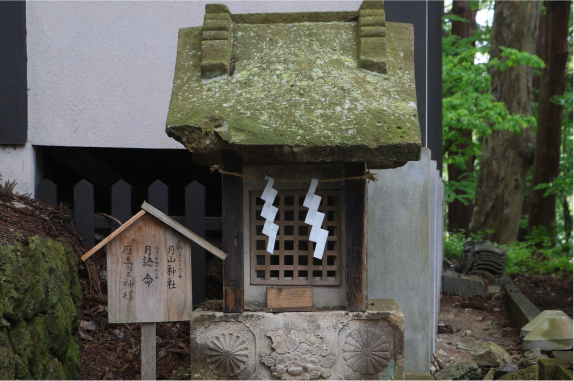
Gassan Shrine
Enshrined Deity: Tsukuyomi no Mikoto
Godly Virtue: Protection from Disasters
Given birth by Izanagi no Mikoto, this god is thought to be the deified moon who commands the night. The “Tsukuyomi” in Tsukuyomi no Mikoto means “Moon Reader”, which is to say counting the moons. Because of its importance in the agricultural calendar, it is worshipped as a god of agriculture.
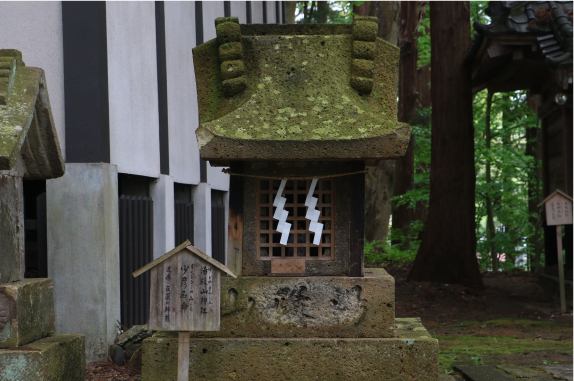
Yudonosan Shrine
Enshrined Deity: Sukunahikona no Mikoto
Godly Virtues: God of Medicine, Wisdom
Said to be the founder of medical knowledge in Japan, and also the god of wisdom.
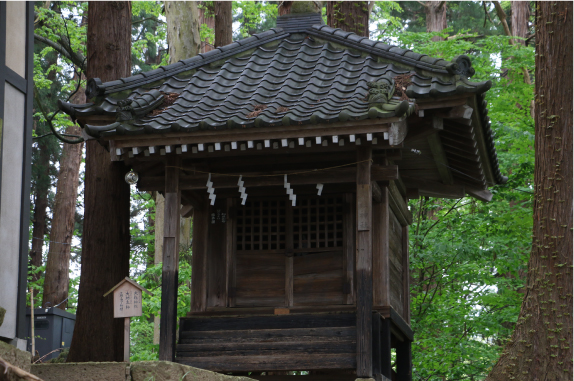
Ohyashiro Shrine
Enshrined Deity: Ohtokonushi no Kami
Godly Virtues: Abundant Harvest, Prosperous Business
A god who commands the ownership of land.
A joy bringing spirit from the divine realms who along with Otoshi brings abundant crops.
Worshipped along with Otoshi as a god of rice and abundant harvests.
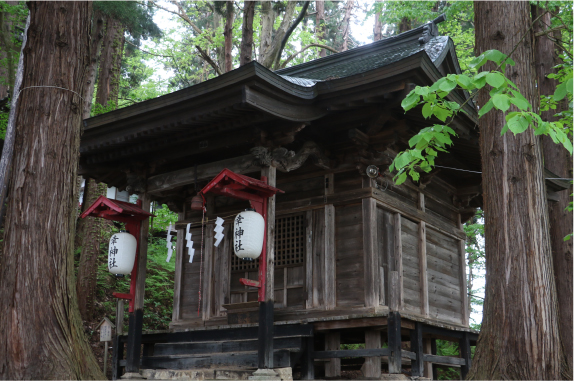
Saiwai Shrine
Enshrined Deity: Sarutahiko no Kami
Buddhist Divinity: Batoh Kannon
Godly Virtues: Traffic Safety, Guardian God of the Horse Zodiac
Worshipped as a god of directions and traffic safety.
The 48,000 Day Festival is on August 10th. It’s said paying a devotional visit on this day gives the benefit of visiting for 48,000 days.
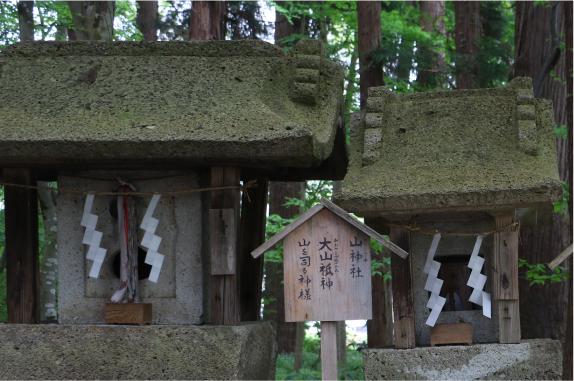
Yama (Mountain) Shrine
Enshrined Deity: Ohyamatzumi no Kami
Godly Virtue: God of Mountains
A god who controls mountains, and is worshipped by people connected with mountains and forestry. Also known under the name of Sakewake no Kami, worshipped as the god who created alcohol brewing.
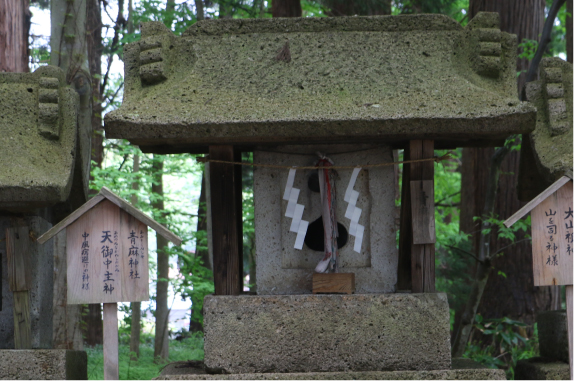
Aoso Shrine
Enshrined Deity: Amenominakanushi no Kami
Godly Virtue: God of Paralysis
Worshipped from ancient time as a god who can heal paralysis.
It’s said that by paying three devotional visits one can prevent paralysis for all of one’s life.
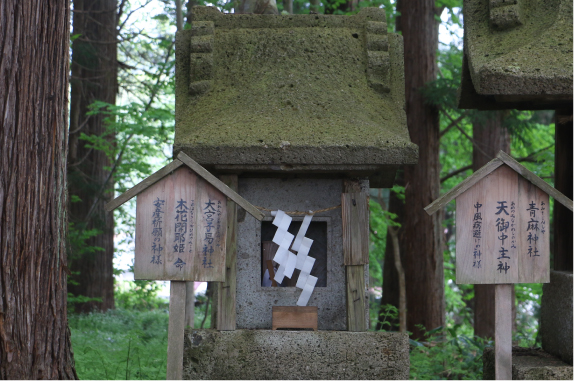
Ohmiyakoyasu Shrine
Enshrined Deity: Konohanasakuyahime no Kami
Godly Virtue: Easy Childbirth
Because of the story that she gave birth safely in the middle of a fire, from ancient times worshipped for prayers for easy childbirth.

Furumine Shrine
Enshrined Deity: Yamatotakeru no Mikoto
Godly Virtue: Disaster Prevention
Godly Virtue: Fire Prevention
Because Yamatotakeru no Mikami escaped from fire in Yaizu no Hara (in modern day Shizuoka Prefecture), he is believed all over Japan from ancient times to be the god of fire prevention, and is worshipped as a god with the power to stop and protect people from fires.
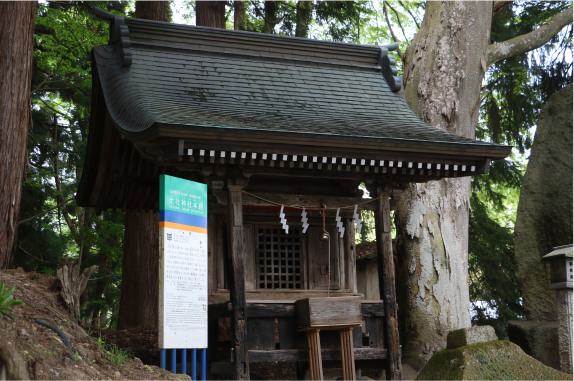
Dosha Shrine
Enshrined Deity: Kashikone no Kami
Buddhist Divinity: Fudoh-Miyoh
Godly Virtues: Protection from Disasters, Guardian God of the Cock Zodiac
The wife of Omodaru no Kami, the god made from clay who first took human shape.
A god who shows gratitude for the generative power of nature to bring forth and raise living things, it is worshipped with gratitude for nature and the land
●Designated Prefectural Cultural Property Traditional Shinto ikkenja style, built in the Muromachi Period.
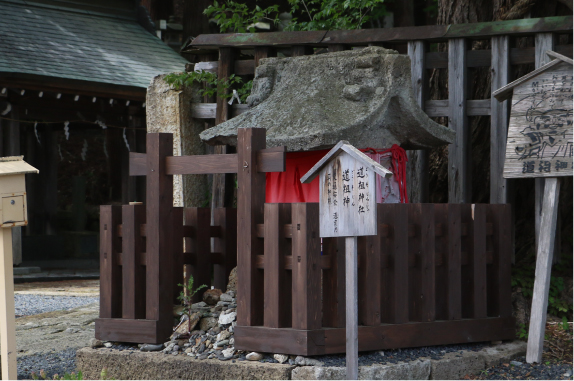
Dohso Shrine
Enshrined Deity: Dohsojin
Godly Virtue: Traffic safety, Recovery from ear disease
The god of directions and traffic safety. Also worshipped as the god of ears, prayed to on March 3rd, Ear Day.
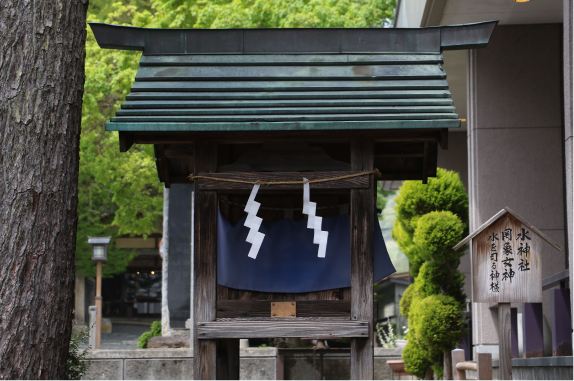
Mizu Jinja (Water Shrine)
Enshrined Deity: Mizuuhanome no Kami
Godly Virtue: God of Water
Water washes away human impurities and makes our bodies clean. Not only that, water has the power to bring forth new life.
It is worshipped as a god who purifies our bodies and gives us abundant life.

Haiden Worship Hall
The worship hall was believed to have been constructed at the end of the Edo Period, but an ink document from 1787 was discovered during repairs undertook on the roof in 2006, indicating it was built before this year. Because base wood of a much older age than construction of the time was used, research has inferred that the original construction was long before 1787. Also, according to an investigation undertaken at this time, it was proven that it was one of the first in Japan to use the thatched roof architecture style representative of the snow country of Yamagata. The cusped gables and decorated gables thatched with reeds is particular to Yamagata Prefecture and can be seen at the three shrines of Dewa Sanzan and Sasano Kannon, but the Haiden Worship Hall of Kumano Taisha is the oldest of these.
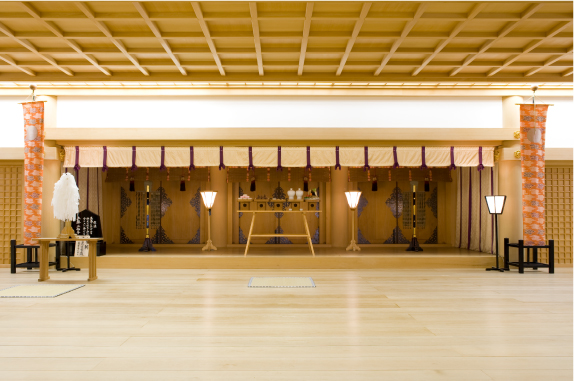
Heiden (Hall of Offerings)
Constructed in 1985. To dedicate the grand Kagura performance as passed down from Grand Ise Shrine, it was built to be the same as the Ise Shrine kagura stage.
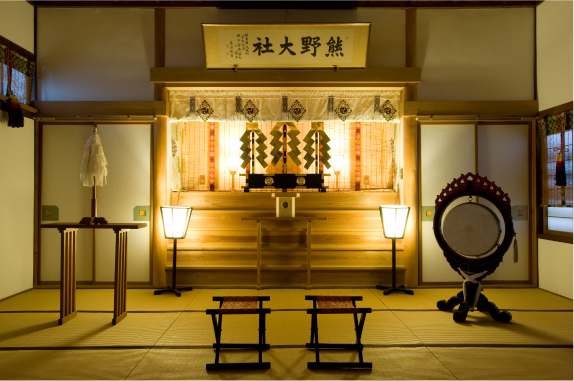
Satoden
A prayer hall where worshippers can pray.
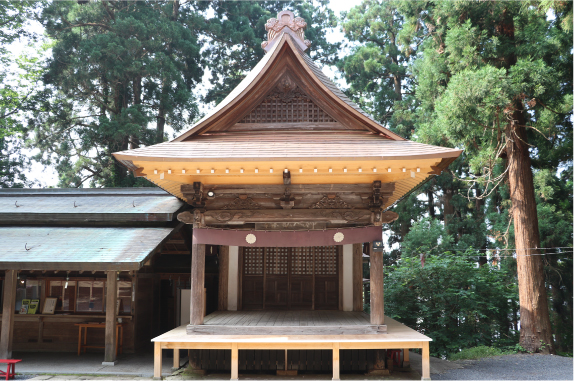
Kaguraden
A shrine for dedication dances. “Chigomai” dance is performed here on July23rd, the night before the festival of the 24th.
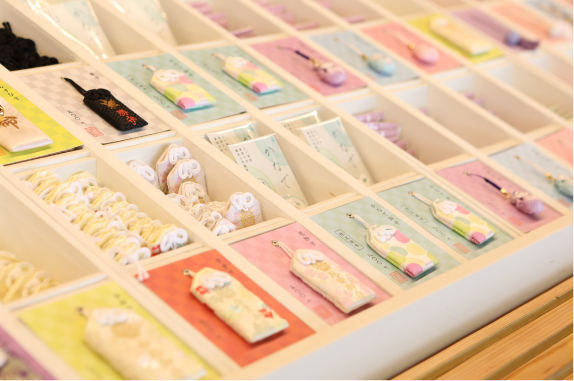
Jyuyosho Charm Shop
A building for dispensing talismans and charms. Applications for prayer are also accepted at Jyuyosho.
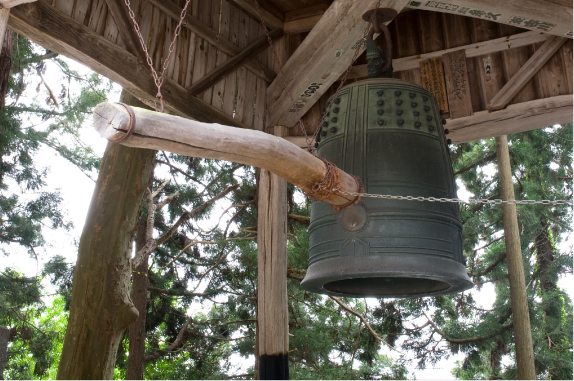
Shoro Bell Tower
A big temple bell donated in 1626. During WW2, all metal in the country was ordered confiscated, but this bell was exempted because of it cultural importance. It is rung 3 times in the morning, noon, and night, every day without exemption.
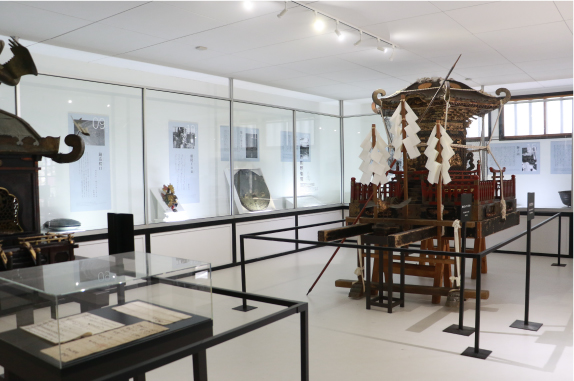
Kumano Kohkokan Museum
Many cultural properties are exhibited here. ※Kumano Kohkokan
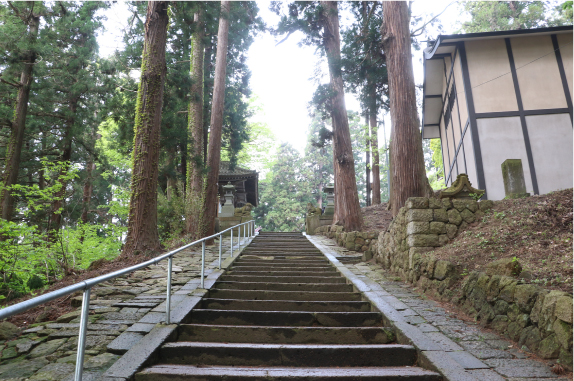
Omisaka Steps
46 stone steps.
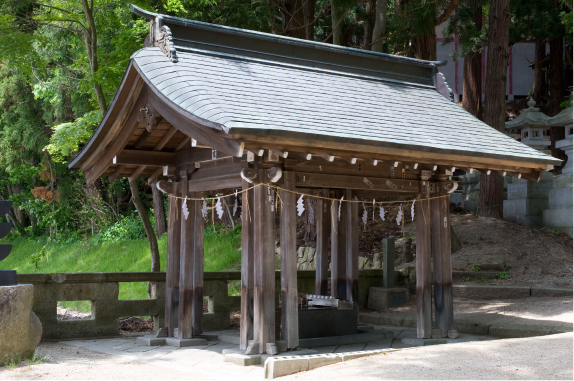
Temizusha
A place for ritual cleansing of hands and rinsing of mouth before worship. It is a ritual to cleanse the body before appearing before the gods, and it’s said that this is the simplification of ritual ablution at a river.
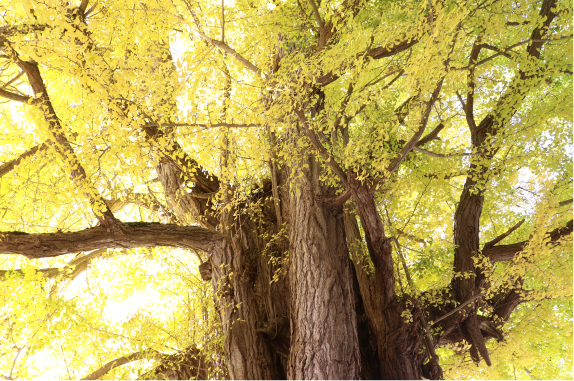
Ooichoh Big Ginko
In ancient times when the Tohoku area was shaken by the Former 9 Years War, Minamoto no Yoshiie vowed victory at this shrine, and by its wondrous power was able to fulfill his duty.
Afterward, when Yoshiie served for 3 years as provincial governor, he entrusted his retainer Kamakura Gengoro Kagemasa to pray for his victory, and on that occasion, it is said the tree was planted by his hand,
● Designated Prefectural Cultural Property Natural Monument

Kagami-ike (Mirror Pond)
During the Mongol Invasions of the Kamakura period, Japan faced an unprecedented national crisis. The Emperors of the time, Emperor Kameyama and Emperor Gohda offered prayers to defeat the enemy at Ise Shrine, and this shrine also received imperial orders from great distances to offer prayer. At that time, the remains of the hall where the imperial envoy sequestered himself for prayer was filled with water and became the Mirror Pond, and the pond along with the Chokushi bridge are preserved as holy places.

Chokushi Bridge
During the Mongol Invasions of the Kamakura period, Japan faced an unprecedented national crisis. The Emperors of the time, Emperor Kameyama and Emperor Gohda offered prayers to defeat the enemy at Ise Shrine, and this shrine also received imperial orders from great distances to offer prayer. At that time, the remains of the hall where the imperial envoy sequestered himself for prayer was filled with water and became the Mirror Pond, and this bridge along with the pond are preserved as holy places.
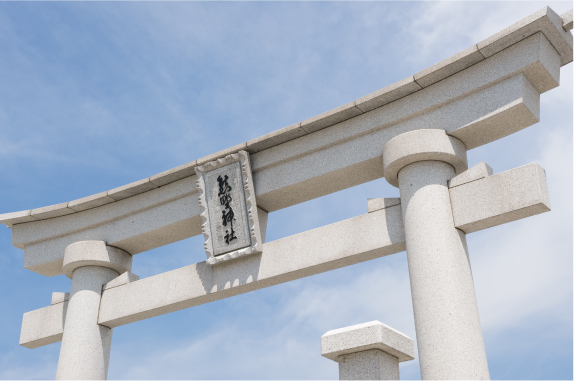
Large Torii Gate
This was constructed partly to commemorate the 1200th anniversary of the shrine’s
construction. It is with pride that it is the best in Japan in scale made of stone and built in a traditional Shinto style.

Behind the Main Hall
Behind the main hall are three carvings of rabbits are hidden, and it is said that those who find all of them will have no money problems, will be happy, and will have their requests granted.
